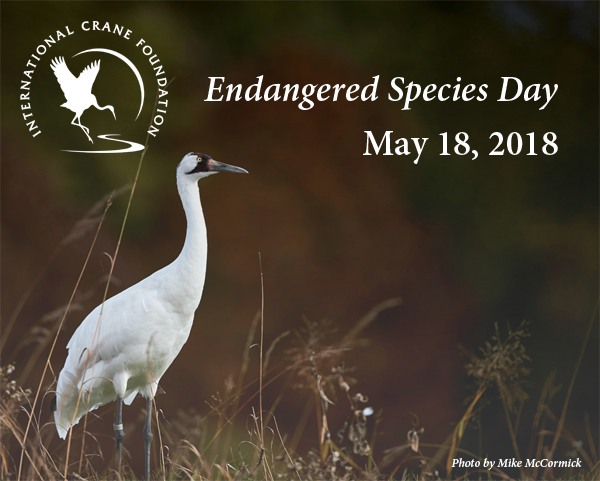
What is Endangered Species Day?
It is a day to learn about endangered species and how we can help protect them. In celebration of the 13th annual Endangered Species Day on May 18, 2018, we created this “top ten” list about Whooping Cranes to help you learn more about this imperiled – and endangered – species:
1. The Whooping Crane is the tallest bird in North America and the rarest crane species.
2. Adult Whooping Cranes are identified by a red skin patch on their forehead, black “mustache” and legs, and black wing tips visible in flight.
3. Low population numbers, coupled with the loss of habitat and hunting pressures, nearly caused the Whooping Crane’s extinction in the early 1900s.
4. Beginning in 1967, Whooping Crane eggs were transferred from the last wild breeding grounds at Wood Buffalo National Park in Canada to begin the first captive breeding program at the Patuxent Wildlife Research Center in Maryland.
5. When the Endangered Species Act was passed in 1973, less than 50 Whooping Cranes existed in the wild.
6. In 1989, the International Crane Foundation received 22 Whooping Cranes from Patuxent. Today, we have 44 Whooping Cranes at our headquarters and produce chicks each year for reintroduction into the wild and genetic management of the species.
7. Whooping Cranes typically lay two eggs per clutch. In captivity, our staff often remove eggs from the nest as they are laid or as a clutch is completed. By removing their eggs, a pair is stimulated to produce another clutch, thereby increasing the number of eggs a single pair produces.
8. The last naturally occurring Whooping Crane population migrates more than 2,500 miles from their breeding grounds in western Canada to winter on the coastal wetlands in southern Texas.
9. On their wintering grounds along the Gulf Coast of Texas, Whooping Cranes nearly exclusively feed on blue crabs and wolfberries, which differs from the population’s diet of small mammals, insects and amphibians on their breeding grounds in Canada.
10. Today, nearly 600 Whooping Cranes live in the wild. While this number is slowly rising thanks to the work of the International Crane Foundation and others, the species is still endangered. Help us to continue advocating for and protecting cranes across the globe by becoming a member or making a donation.
